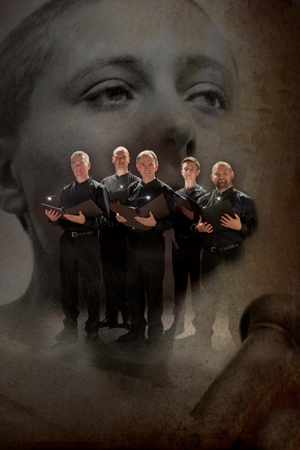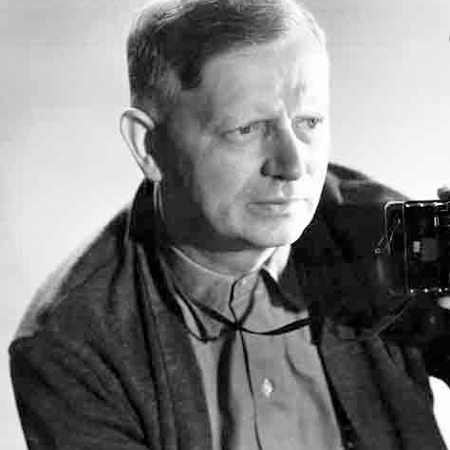by Mike Telin

The question of how to underscore Dreyer’s images with music evaporated in the 1930s, when the original negatives were destroyed by fire. When a perfect print was discovered in 1981 in a Norwegian mental asylum, that whole issue was suddenly revived. Since then, a long list of musicians have taken up the task, ranging from Dutch, Danish, Estonian and Lithuanian composers to electronic groups and rock bands (notably the Canadian group Joan of Arc).
In 2015, in a move that would undoubtedly have pleased Carl Theodor Dreyer, Donald Greig of Britain’s Orlando Consort — a male-voice group specializing in medieval music — devised a score of a cappella music dating from Joan’s lifetime to be sung live along with the film. Cleveland audiences will have the opportunity to see and hear the results on Wednesday, April 6 at 7:30 pm, when Donald Greig, Charles Daniels, Angus Smith, Robert Harre-Jones, and Mark Dobell perform “Voices Appeared” in Gartner Auditorium at the Cleveland Museum of Art. The nearly 50 scenes in the 82-minute film will be paired with pieces of plainchant and polyphony, including works by Guillaume Dufay and Gilles Binchois and the anonymous Agincourt Carol.
“I’ve got a background in film studies, so I knew of the movie, and because of the Orlando Consort I know a lot about medieval music as well,” Greig said in a telephone conversation from England. “I’ve always been interested in film music, so it’s been staring me in the face for about 25 years until I realized that there was a way of combining my interests into one particular project.
“Since then, it’s become more and more obvious that the idea of having music from that period to accompany that film just works on so many levels. Dreyer himself was interested in doing that. He didn’t pursue it, but he mused aloud about the possibility of doing something like this.”
But in 1928, only a handful of medieval pieces had been transcribed so that modern musicians could make sense of and attempt to play them. The situation is different now, thanks to modern scholarship. “There are now about seven large volumes of random early 15th century music by composers whose work was revered during their time. There must be about 500 pieces of music from which one could choose,” Greig said.
“We went through everything that would be feasible for our voices, that would work thematically with the film, or could be justified for inclusion because it might work in certain scenes,” Greig said. “I limited myself to French Burgundian music and English music of the period, but in the end I didn’t use much English music at all.
“The irony is that as a peasant, Joan would never have heard any of the music written for courts and kings. It was only when she had come under the protection of the Dauphin, then captured by the Burgundians and turned over to the English that she would have heard this rich polyphony — but she wouldn’t have been able to whistle any of the tunes. They really did belong to the upper classes.”
In researching the story, Greig discovered that very few of the many biographies of Joan of Arc mention music at all. “One exception is the chant Veni Creator Spiritus which was sung by the monks that accompanied Joan while she was leading the siege of Orleans,” Greig said.
Once Greig had put a plan together, he tested it on focus groups of film and music students. “The music students wanted more silence because for them it was just too rich. And the film students, for whom the music was simply an accompaniment, didn’t want any silence at all. That didn’t surprise me,” Greig said, “but what did surprise me was how universal those responses continued to be when we performed the music with the film. You could guess the demographics of people from the comments they were making.”
The Orlando Concert ended up using quite a bit of silence during the scenes, “and it’s incredibly powerful when it happens — if you time it correctly,” Greig said, pointing out that getting the mixture of music and silence right is the key. “I’m very comfortable sitting and watching a silent movie, but for some people, silence can be quite threatening, and if you have 90 minutes of it, it becomes a different thing.”

Now that the Orlando Consort has produced nearly thirty performances of the project, Greig has come to admire Dreyer’s film more and more. “The real test of any project is how many times you can perform it and not get fed up with it. One of the great things about the project is realizing just how good a movie it is. I’ve seen it about 50 times but I keep discovering and appreciating new things in it.”
Even so, the project continues to evolve. “The last change we made was about three performances ago, where we put a little bit of music back in,” Greig said. “Ultimately, my hope is that we’re responding exactly to what’s happening on the screen.”
Read more of Donald Greig’s reflections on the Orlando Consort’s “Voices Appeared” project here.
Published on ClevelandClassical.com March 29, 2016.
Click here for a printable copy of this article




